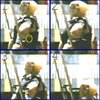Fast Frank
Member
I think part of the problem stems from the assumption that any person using the term "Knockdown power" saw a movie where some powerful gun picked a bad guy up and tossed him like a rag doll, and believed the real world works that way.
Not understanding that the guy using that term is nowhere near that stupid, we then jump on him with both feet and berate him (Smug in our superiority) for believing in something that's as dumb as a Scooby-Doo cartoon.
I can't imagine any person that's fired one whole box of real rifle ammo thinking they could actually lift any animal off it's feet and throw it by hitting it with a bullet. I've never met anybody that stupid, and doubt I ever will.
I'm pretty sure that Good Ol' Boy above is correct. Some bullets have more power than others, and the goal is to put the animal on the ground. Calling it "Knockdown Power" isn't incorrect if you forget about all that science stuff and just accept it as a slang term.
Slang terms, for those that don't know, don't require accuracy. For example, the term that says "You can kiss my" doesn't actually grant permission for anybody to kiss anything. It's merely a slang term that expresses contempt.
Getting all scientific and trying to calculate the mathematical variations of such a smooch doesn't make me smarter, it shows that I don't understand.
Get it?
Not understanding that the guy using that term is nowhere near that stupid, we then jump on him with both feet and berate him (Smug in our superiority) for believing in something that's as dumb as a Scooby-Doo cartoon.
I can't imagine any person that's fired one whole box of real rifle ammo thinking they could actually lift any animal off it's feet and throw it by hitting it with a bullet. I've never met anybody that stupid, and doubt I ever will.
I'm pretty sure that Good Ol' Boy above is correct. Some bullets have more power than others, and the goal is to put the animal on the ground. Calling it "Knockdown Power" isn't incorrect if you forget about all that science stuff and just accept it as a slang term.
Slang terms, for those that don't know, don't require accuracy. For example, the term that says "You can kiss my" doesn't actually grant permission for anybody to kiss anything. It's merely a slang term that expresses contempt.
Getting all scientific and trying to calculate the mathematical variations of such a smooch doesn't make me smarter, it shows that I don't understand.
Get it?



